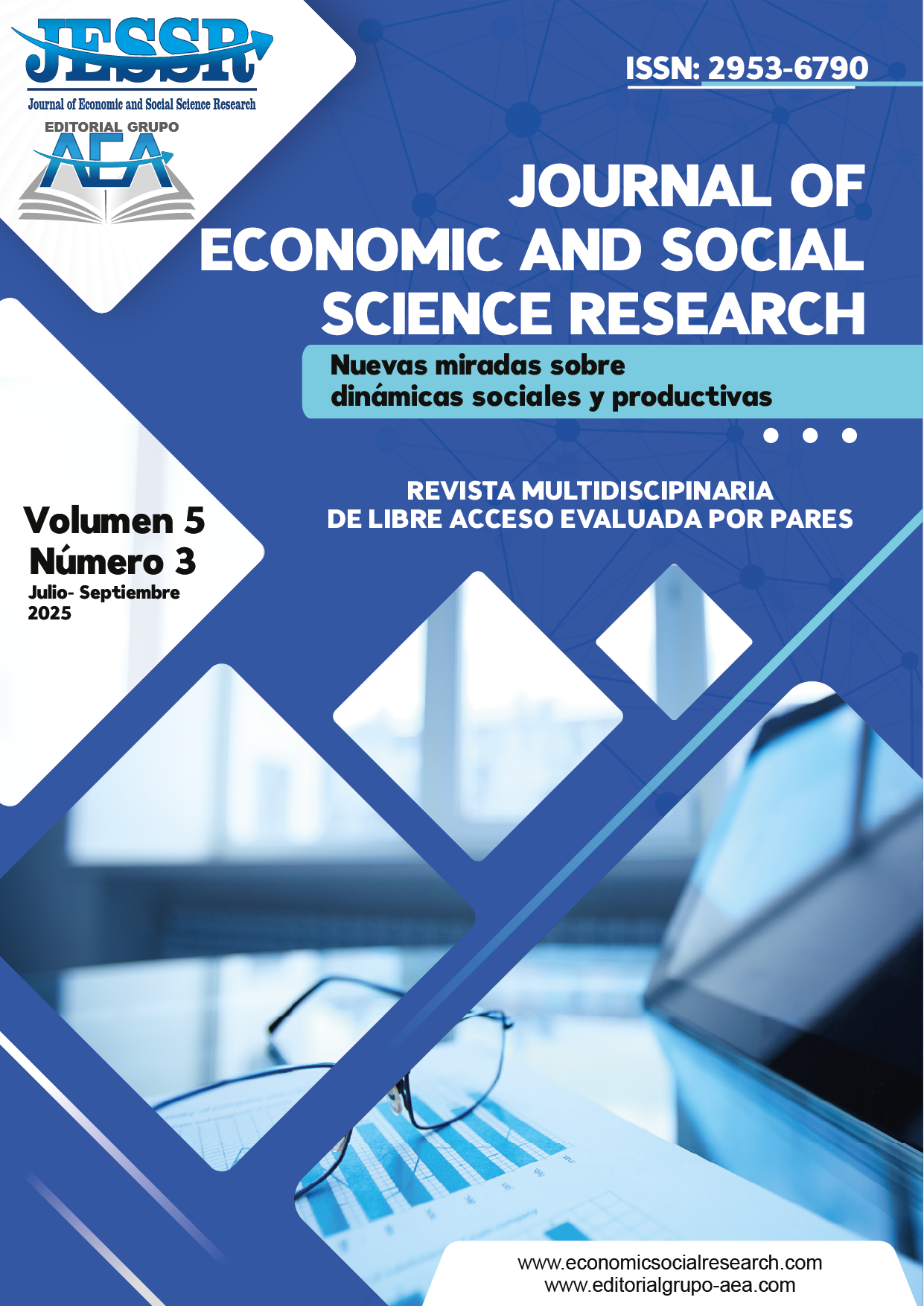Reading errors and fluency in second-grade children in general basic education
Main Article Content
Abstract
This study comprehensively analyzes the relationship between reading errors and fluency in children in the second grade of general basic education, considering that this stage represents a critical phase for the acquisition of fundamental reading skills. Through a systematic literature review of research published in the last two decades, we identified the most frequent types of reading errors (omissions, substitutions, inversions and repetitions), their causes and consequences, as well as the factors affecting fluency, including phonological deficit, limited vocabulary, poor reading practice and inadequate pedagogical methods. The results reveal that the persistence of these errors compromises not only the automation of the reading process, but also students' comprehension, motivation and school performance. Likewise, effective strategies such as repeated reading, modeling, paired reading and the multisensory approach are highlighted, which have shown positive results in the development of fluency. The study concludes that reading fluency is a complex skill that requires early and comprehensive educational intervention based on scientific evidence, as well as adequate teacher training to identify, prevent and correct reading errors in a timely manner.
Downloads
Article Details
Section

This work is licensed under a Creative Commons Attribution-NonCommercial 4.0 International License.
How to Cite
References
Agudelo-Valdeleón, O. L. (2024). El impacto de la neuropsicopedagogía en la mejora del aprendizaje. Journal of Economic and Social Science Research, 4(2), 226–245. https://doi.org/10.55813/gaea/jessr/v4/n2/109 DOI: https://doi.org/10.55813/gaea/jessr/v4/n2/109
Andino-Jaramillo, R. A., & Palacios-Soledispa, D. L. (2023). Investigación para la aplicación de una estrategia de mejoramiento del clima laboral en una unidad educativa. Journal of Economic and Social Science Research, 3(3), 52–75. https://doi.org/10.55813/gaea/jessr/v3/n3/73 DOI: https://doi.org/10.55813/gaea/jessr/v3/n3/73
Anthony, J. L., & Francis, D. J. (2005). Development of phonological awareness. Current Directions in Psychological Science, 14(5), 255–259. https://doi.org/10.1111/j.0963-7214.2005.00376.x DOI: https://doi.org/10.1111/j.0963-7214.2005.00376.x
Casanova-Villalba, C. I., Herrera-Sánchez, M. J., Bravo-Bravo, I. F., & Barba-Mosquera, A. E. (2024). Transformación de universidades incubadoras a creadoras directas de empresas Spin-Off. Revista De Ciencias Sociales, 30(2), 305-319. https://doi.org/10.31876/rcs.v30i2.41911 DOI: https://doi.org/10.31876/rcs.v30i2.41911
Castles, A., & Coltheart, M. (1993). Varieties of developmental dyslexia. Cognition, 47(2), 149–180. https://doi.org/10.1016/0010-0277(93)90003-E DOI: https://doi.org/10.1016/0010-0277(93)90003-E
Catts, H. W., Herrera, S., Nielsen, D. C., & Bridges, M. (2015). Early prediction of reading comprehension within the simple view framework. Reading and Writing, 28(9), 1407–1425. https://doi.org/10.1007/s11145-015-9576-x DOI: https://doi.org/10.1007/s11145-015-9576-x
Coltheart, M., Rastle, K., Perry, C., Langdon, R., & Ziegler, J. (2001). DRC: A dual route cascaded model of visual word recognition and reading aloud. Psychological Review, 108(1), 204–256. https://doi.org/10.1037/0033-295X.108.1.204 DOI: https://doi.org/10.1037//0033-295X.108.1.204
Concha-Ramirez, J. A. (2023). Impacto de la gamificación en la motivación y el compromiso estudiantil en educación primaria. Revista Científica Ciencia Y Método, 1(4), 44-55. https://doi.org/10.55813/gaea/rcym/v1/n4/22 DOI: https://doi.org/10.55813/gaea/rcym/v1/n4/22
Dehaene, S., Cohen, L., Morais, J., & Kolinsky, R. (2015). Illiterate to literate: Behavioural and cerebral changes induced by reading acquisition. Nature Reviews Neuroscience, 16(4), 234–244. https://doi.org/10.1038/nrn3924 DOI: https://doi.org/10.1038/nrn3924
Fajardo-Garcia, L. M. (2025). Estrategias de enseñanza basadas en el contexto sociocultural en la asignatura de educación para la ciudadanía. Revista Científica Zambos, 4(1), 61-73. https://doi.org/10.69484/rcz/v4/n1/76 DOI: https://doi.org/10.69484/rcz/v4/n1/76
Fuchs, L. S., Fuchs, D., Hosp, M. K., & Jenkins, J. R. (2001). Oral reading fluency as an indicator of reading competence: A theoretical, empirical, and historical analysis. Scientific Studies of Reading, 5(3), 239–256. https://doi.org/10.1207/S1532799XSSR0503_3 DOI: https://doi.org/10.1207/S1532799XSSR0503_3
Hasbrouck, J. E., & Tindal, G. (1992). Curriculum‐based oral reading fluency norms for students in grades 2 through 5. Teaching Exceptional Children, 24(3), 41–44. https://doi.org/10.1177/004005999202400310 DOI: https://doi.org/10.1177/004005999202400310
Herman, P. A. (1985). The effect of repeated reading on reading rate, speech pauses, and word recognition accuracy. Reading Research Quarterly, 20(4), 553–565. https://doi.org/10.2307/747942 DOI: https://doi.org/10.2307/747942
Herrera-Sánchez, M. J., Casanova- Villalba, C. I., Moreno-Novillo, Ángela C., & Mina-Bone, S. G. (2024). Tecnoestrés en docentes universitarios con funciones académicas y administrativas en Ecuador. Revista Venezolana De Gerencia, 29(11), 606-621. https://doi.org/10.52080/rvgluz.29.e11.36 DOI: https://doi.org/10.52080/rvgluz.29.e11.36
Khalid, N. M., Buari, N. H., & Chen, A. H. (2017). Comparison of oral reading errors between contextual sentences and random words among schoolchildren. International Education Studies, 10(1), 47–55. https://doi.org/10.5539/ies.v10n1p47 DOI: https://doi.org/10.5539/ies.v10n1p47
Loor Giler, J. L., Lorenzo Benítez, R., & Herrera Navas, C. D. (2021). Manual de actividades didácticas para el desarrollo de la comprensión lectora en estudiantes de subnivel de básica media. Journal of Economic and Social Science Research, 1(1), 15–37. https://doi.org/10.55813/gaea/jessr/v1/n1/18 DOI: https://doi.org/10.55813/gaea/jessr/v1/n1/18
Mol, S. E., & Bus, A. G. (2011). To read or not to read: A meta-analysis of print exposure from infancy to early adulthood. Psychological Bulletin, 137(2), 267–296. https://doi.org/10.1037/a0021890 DOI: https://doi.org/10.1037/a0021890
Ouellette, G., & Beers, A. (2010). A not-so-simple view of reading: How oral vocabulary and visual-word recognition complicate the story. Reading and Writing, 23, 189–208. https://doi.org/10.1007/s11145-008-9159-1 DOI: https://doi.org/10.1007/s11145-008-9159-1
Pacheco-Altamirano, A. M., Camposano-Córdova, A. I., Torres-Acevedo, C. L., Oré-Rojas, J. J., Gavidia-Anticona, J. A., Yauri-Huiza, Y., & Rojas-Quispe, Ángel E. (2023). Comprendiendo la Lectura: Del Nivel Literal al Crítico en Estudiantes de EBA. Editorial Grupo AEA. https://doi.org/10.55813/egaea.l.2022.40 DOI: https://doi.org/10.55813/egaea.l.2022.40
Perfetti, C. A., & Stafura, J. Z. (2013). Word knowledge in a theory of reading comprehension. Scientific Studies of Reading, 18(1), 22–37. https://doi.org/10.1080/10888438.2013.827687 DOI: https://doi.org/10.1080/10888438.2013.827687
Puyol-Cortez, J. L., & Piedra-Castro, W. I. (2023). Evaluación del impacto de la educación emocional en el rendimiento académico en adolescentes. Revista Científica Ciencia Y Método, 1(1), 42-54. https://doi.org/10.55813/gaea/rcym/v1/n1/9 DOI: https://doi.org/10.55813/gaea/rcym/v1/n1/9
Romero-Reyes, H. D., Castro-Chaguala, D. C., González-Martínez, E., & Patiño-Mejia, A. (2024). Análisis de validez de Escala del nuevo paradigma ecológico (NEP-R) en estudiantes de psicología de la universidad de la Amazonía y Universidad Fundes. Journal of Economic and Social Science Research, 4(2), 271–285. https://doi.org/10.55813/gaea/jessr/v4/n2/112 DOI: https://doi.org/10.55813/gaea/jessr/v4/n2/112
Shaywitz, S. E., Shaywitz, B. A., Pugh, K. R., Fulbright, R. K., Mencl, W. E., Constable, R. T., … & Gore, J. C. (2002). Disruption of posterior brain systems for reading in children with developmental dyslexia. Biological Psychiatry, 52(2), 101–110. https://doi.org/10.1016/S0006-3223(02)01365-3 DOI: https://doi.org/10.1016/S0006-3223(02)01365-3
Torres-Roberto, M. A., & Solano-Camargo, S. P. (2025). La baja natalidad en Colombia y su impacto en la educación pública y privada. Revista Científica Zambos, 4(2), 240-264. https://doi.org/10.69484/rcz/v4/n2/120 DOI: https://doi.org/10.69484/rcz/v4/n2/120





